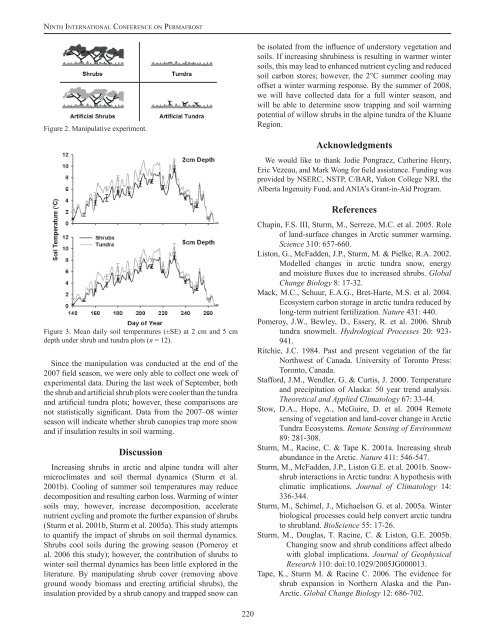Ninth International Conference on Permafrost ... - IARC Research
Ninth International Conference on Permafrost ... - IARC Research
Ninth International Conference on Permafrost ... - IARC Research
You also want an ePaper? Increase the reach of your titles
YUMPU automatically turns print PDFs into web optimized ePapers that Google loves.
Ni n t h In t e r n at i o n a l Co n f e r e n c e o n Pe r m a f r o s tFigure 2. Manipulative experiment.Figure 3. Mean daily soil temperatures (±SE) at 2 cm and 5 cmdepth under shrub and tundra plots (n = 12).Since the manipulati<strong>on</strong> was c<strong>on</strong>ducted at the end of the2007 field seas<strong>on</strong>, we were <strong>on</strong>ly able to collect <strong>on</strong>e week ofexperimental data. During the last week of September, boththe shrub and artificial shrub plots were cooler than the tundraand artificial tundra plots; however, these comparis<strong>on</strong>s arenot statistically significant. Data from the 2007–08 winterseas<strong>on</strong> will indicate whether shrub canopies trap more snowand if insulati<strong>on</strong> results in soil warming.Discussi<strong>on</strong>Increasing shrubs in arctic and alpine tundra will altermicroclimates and soil thermal dynamics (Sturm et al.2001b). Cooling of summer soil temperatures may reducedecompositi<strong>on</strong> and resulting carb<strong>on</strong> loss. Warming of wintersoils may, however, increase decompositi<strong>on</strong>, acceleratenutrient cycling and promote the further expansi<strong>on</strong> of shrubs(Sturm et al. 2001b, Sturm et al. 2005a). This study attemptsto quantify the impact of shrubs <strong>on</strong> soil thermal dynamics.Shrubs cool soils during the growing seas<strong>on</strong> (Pomeroy etal. 2006 this study); however, the c<strong>on</strong>tributi<strong>on</strong> of shrubs towinter soil thermal dynamics has been little explored in theliterature. By manipulating shrub cover (removing aboveground woody biomass and erecting artificial shrubs), theinsulati<strong>on</strong> provided by a shrub canopy and trapped snow canbe isolated from the influence of understory vegetati<strong>on</strong> andsoils. If increasing shrubiness is resulting in warmer wintersoils, this may lead to enhanced nutrient cycling and reducedsoil carb<strong>on</strong> stores; however, the 2°C summer cooling mayoffset a winter warming resp<strong>on</strong>se. By the summer of 2008,we will have collected data for a full winter seas<strong>on</strong>, andwill be able to determine snow trapping and soil warmingpotential of willow shrubs in the alpine tundra of the KluaneRegi<strong>on</strong>.AcknowledgmentsWe would like to thank Jodie P<strong>on</strong>gracz, Catherine Henry,Eric Vezeau, and Mark W<strong>on</strong>g for field assistance. Funding wasprovided by NSERC, NSTP, C/BAR, Yuk<strong>on</strong> College NRI, theAlberta Ingenuity Fund, and ANIA’s Grant-in-Aid Program.ReferencesChapin, F.S. III, Sturm, M., Serreze, M.C. et al. 2005. Roleof land-surface changes in Arctic summer warming.Science 310: 657-660.List<strong>on</strong>, G., McFadden, J.P., Sturm, M. & Pielke, R.A. 2002.Modelled changes in arctic tundra snow, energyand moisture fluxes due to increased shrubs. GlobalChange Biology 8: 17-32.Mack, M.C., Schuur, E.A.G., Bret-Harte, M.S. et al. 2004.Ecosystem carb<strong>on</strong> storage in arctic tundra reduced byl<strong>on</strong>g-term nutrient fertilizati<strong>on</strong>. Nature 431: 440.Pomeroy, J.W., Bewley, D., Essery, R. et al. 2006. Shrubtundra snowmelt. Hydrological Processes 20: 923-941.Ritchie, J.C. 1984. Past and present vegetati<strong>on</strong> of the farNorthwest of Canada. University of Tor<strong>on</strong>to Press:Tor<strong>on</strong>to, Canada.Stafford, J.M., Wendler, G. & Curtis, J. 2000. Temperatureand precipitati<strong>on</strong> of Alaska: 50 year trend analysis.Theoretical and Applied Climatology 67: 33-44.Stow, D.A., Hope, A., McGuire, D. et al. 2004 Remotesensing of vegetati<strong>on</strong> and land-cover change in ArcticTundra Ecosystems. Remote Sensing of Envir<strong>on</strong>ment89: 281-308.Sturm, M., Racine, C. & Tape K. 2001a. Increasing shrubabundance in the Arctic. Nature 411: 546-547.Sturm, M., McFadden, J.P., List<strong>on</strong> G.E. et al. 2001b. Snowshrubinteracti<strong>on</strong>s in Arctic tundra: A hypothesis withclimatic implicati<strong>on</strong>s. Journal of Climatology 14:336-344.Sturm, M., Schimel, J., Michaels<strong>on</strong> G. et al. 2005a. Winterbiological processes could help c<strong>on</strong>vert arctic tundrato shrubland. BioScience 55: 17-26.Sturm, M., Douglas, T. Racine, C. & List<strong>on</strong>, G.E. 2005b.Changing snow and shrub c<strong>on</strong>diti<strong>on</strong>s affect albedowith global implicati<strong>on</strong>s. Journal of Geophysical<strong>Research</strong> 110: doi:10.1029/2005JG000013.Tape, K., Sturm M. & Racine C. 2006. The evidence forshrub expansi<strong>on</strong> in Northern Alaska and the Pan-Arctic. Global Change Biology 12: 686-702.220
















